

Best Marine Toilet Paper For Boats – The Top Rated!

If you’re a boat owner, you know how important it is to have the right toilet paper on board. Regular household toilet paper isn’t recommended, as it can clog your boat’s sanitation system and lead to costly repairs. So it’s crucial to make the right choice.
There are various types of marine toilet paper, which can make things a little more challenging. But hey, no worries, I am here to help. I’ve prepared a list of the best marine toilet paper for boats and a buying guide so that you can make the best choice.
This post contains affiliate links. If you use these links to buy something, we may earn a commission. Thanks.”
- BEST RATED: Scott Rapid Dissolving Toilet Paper
- TOP PICK: Thetford Aqua Soft Toilet Tissue
- ALSO GREAT: Camco RV Bathroom Toilet Paper
Table of Contents
1. Thetford Aqua-Soft Toilet Tissue
Average Rank: 4.6 out of 5

When you’re out on the water, the last thing you want to deal with is a messy clog in your waste system. That’s where the Thetford Aqua-Soft Toilet Tissue comes in.
This 2-ply toilet paper is designed specifically for RV and marine sanitation systems, and as such, it dissolves rapidly to prevent clogs and keep your system running smoothly.
Not only is Aqua-Soft Toilet Tissue effective in preventing clogs, but it’s also comfortable to use. The soft and highly absorbent sheets will make you feel like you’re using regular toilet paper.
Furthermore, this toilet paper is biodegradable, so you can be confident that you’re making an environmentally friendly choice.
The Thetford Aqua-Soft Toilet Tissue comes in packs of four rolls with 396 sheets per roll. While it is a little more expensive than regular toilet paper, users report it’s well worth the investment for the peace of mind it provides when dealing with marine waste systems.
What Users Liked
- Lots found it very soft on the skin.
- Several say it dissolves fast and completely.
- Many reported it’s great value for the money.
- Many didn’t have clogging issues.
What Users Disliked
- Some found it too expensive.
- A few found it too thin for their liking.
- Several were disappointed there were only 4 rolls.
Specifications
- Brand: Thetford
- Eco-Friendly: 100% Biodegradable
- Ply Rating: 2-Ply
- Sheet Count: 1584
- Number Of Rolls: 4
- Number Of Sheets Per Roll: 396
- Dimensions: 4 x 1.7 x 9 inches
- Weight: 15.8 Ounces (448 Gr)
2. Scott Rapid-Dissolving Toilet Paper
Average Rank: 4.7 out of 5

You’ll definitely be impressed with the Scott Rapid-Dissolving Toilet Paper during your daily routines. When you use it, you’ll notice that it’s gentle on your skin and doesn’t cause any irritation.
Having 48 regular rolls in a pack, each with 231 sheets, you’ll have enough toilet paper for a long boat trip.
One of the greatest things about this product is how quickly it breaks down – 10 times faster than other leading brands.
This feature makes it perfect for sensitive plumbing systems, as it effectively reduces the risk of clogged pipes. Plus, you can feel good about using this eco-friendly option, knowing that it’s 100% biodegradable.
Even though it’s only a 1-ply toilet paper, the Scott Rapid-Dissolving Toilet Paper is still highly absorbent and doesn’t sacrifice comfort.
It’s unscented, which can be a downside if you prefer a more fragrant experience. On the other hand, it’s excellent if you have allergies or sensitivities to scents.
What Users Like
- Most say it breaks down quickly and doesn’t clog up the toilet.
- Many love the softness of the tissue on the skin.
- A large majority report that it’s strong and super absorbent.
What Users Dislike
- Some report that the sheets are too thin and the rolls run out fast.
- A few say it’s poor quality.
- Several find it a little pricey for their liking.
- Brand: Scott Rapid Dissolving
- Sheet Count: 11088
- Number Of Rolls: 48 Rolls
- Ply Rating: 1-Ply
- Number Of Sheets Per Roll: 231
- Product Dimensions: 17.75 x 17.75 x 16.13 inches
- Item Weight: 1 pound (453Gr)
3. Better Boat Toilet Paper

The Better Boat Toilet Paper is specifically designed to dissolve quickly, preventing any issues with your marine, RV, or camping toilet systems. In addition, the 2-ply sheets provide both strength and softness, ensuring you won’t trade comfort for practicality.
One of the most significant advantages of this toilet paper is its eco-friendly quality. It’s biodegradable, which means it won’t harm the environment when disposed of properly. Additionally, the toilet paper is dye and fragrance-free, making it suitable for sensitive skin.
However, there are a few potential downsides to consider. Some users may find that the Better Boat Toilet Paper isn’t as plush and luxurious as the toilet paper they use at home. It’s also individually wrapped, which might seem like unnecessary packaging, but it does keep each roll dry and clean in wet or humid environments.
Lastly, it may be a bit more expensive than regular toilet paper, but considering its septic-safe and eco-friendly features, it’s a worthwhile investment for your boating or RV adventures.
- Many found it strong and soft.
- A large majority reported it dissolves fast and doesn’t clog up.
- Several found it practical that the rolls were individually wrapped.
- Many love that it’s eco-friendly.
- Some said it could be a lot softer.
- Several found it a little pricy compared to household toilets.
- Brand: Better Boat
- Sheet Count: 6000
- Number Of Rolls: 12
- Number Of Sheets Per Roll: 500
- Dimensions: 16 x 12 x 4 inches
- Weight: 4.25 Pounds (1927 Gr)
4. STAR BRITE Toilet Tissue Marine/RV Grade
Average Rank: 4.4 out of 5

The STAR BRITE Toilet Tissue is made from 100% recycled, non-bleached fibers, so it’s an eco-friendly choice to include in your marine supplies. Not only is it gentle on the environment, but it’s also gentle on your skin.
The soft 2-ply sheets keep you comfortable during use, which is important when you’re away from home. However, be aware that this toilet paper only contains 4 mega rolls, so you may need to buy more frequently than you would with other brands.
One of the standout features of this tissue is how quickly it breaks down, preventing clogs and ensuring smooth sailing for your marine or RV toilet system.
While this is an excellent benefit, the product is a bit pricier than some alternatives. Nevertheless, many users believe the performance and eco-friendliness justify the cost.
In summary, if you’re looking for marine toilet paper that’s environmentally friendly, gentle on the skin, and reliable in terms of dissolving quickly in your plumbing system, the STAR BRITE Toilet Tissue is a solid choice for you.
- Many reported that it works as advertised.
- A good amount was happy about the quality.
- Many found it sturdy and Soft.
- Some found the rolls too small for the price.
- Several said it’s thin and flimsy.
- Brand: Star Brite
- Sheet Count: 2000
- Dimensions: 4.75 x 9.5 x 10 inches
- Weight: 0.88 Pounds (399 Gr)
5. Camco Bathroom Toilet Tissue

This Camco Boat/Rv Bathroom Toilet Tissue offers a great combination of softness and strength, with its 2-ply construction providing durability for your boat bathroom needs.
Since it’s designed specifically for RV and marine use, you won’t have to worry about clogging your system or harming the environment, as it’s both flushable and biodegradable.
While some users might find it more costly than other options, you’ll likely appreciate the peace of mind of knowing that these toilet rolls won’t cause any problems with your septic tank.
In addition, the absence of dyes and perfumes ensures that the toilet paper is gentle on your skin, reducing potential irritation.
In conclusion, Camco offers a generous pack of 16 rolls and 500 sheets per roll, giving ample supply for boating trips.
- Many found it comfortable and soft.
- Many reported that it breaks down quickly.
- Some said it’s less expensive than other brands.
- A large amount said it absorbs extremely well and dissolves fast.
- Some found it very rough and not sturdy.
- Several said it was too pricey.
- A few reported that the sheet was too thin.
- Brand: Camco
- Sheet Count: 8000
- Number Of Rolls: 16
- Package Dimensions: 18.7 x 9.4 x 8.6 inches
- Weight: 6.19 pounds (2807Gr)
6. Commodore LUXSOFT
Average Rank: 4.1 out of 5

When it comes to providing optimal luxury and convenience for your RV, marine, or home septic system, you can’t go wrong with Commodore LUXSOFT Premium 3-Ply Luxury toilet paper.
This white, eco-friendly toilet paper has been designed specifically to cater to your unique sanitation needs.
You’ll immediately notice the difference when you use LUXSOFT’s Premium 3-Ply toilet paper. It is ultra-soft and highly absorbent, outperforming single-ply or 2-ply options. Its quick-dissolving feature will save you both time and headaches.
You can say goodbye to clogs or other drainage issues commonly associated with traditional toilet paper.
This product is perfect for RV and marine systems and works wonders in home septic systems and other waste applications such as camping and offices. The 6-roll pack, each containing 300 sheets, ensures you’ll always have enough for your adventures.
While some users have mentioned clogging issues or a higher price than alternatives, the overall satisfaction with the product is evident in its 4.1-star rating.
- Many said it’s highly absorbent.
- Some commented that it’s soft and doesn’t fall apart.
- Several reported that the sheet is soft and durable.
- Some found the cost too exaggerated.
- Some report clogging issues.
- Several said it’s not as soft as other brands’ toilet paper.
- Brand: Luxurious
- Sheet Count: 1800
- Number Of Rolls: 6
- Ply Rating: 3-Ply
- Number Of Sheets Per Roll: 300
- Package Dimensions: 13.62 x 8.82 x 4.21 inches
- Weight: 2.38 pounds (1079Gr)
7. Freedom Living RV/Boat Toilet Paper

The Freedom Living boat Toilet Paper is an excellent choice, as it dissolves completely in just minutes, preventing any unwanted clogs in your boat holding tanks.
The 2-ply, 500-sheet rolls offer sufficient thickness, so you won’t accidentally poke your finger through the paper. Though it may not be as absorbent as the toilet paper you use at home, it strikes an ideal balance between softness and quick-dissolving capabilities.
With 4000 sheets, the 8 Pack will last a while on your trips, letting you enjoy more fun leisure time without worrying about finding the next pack of toilet paper.
In addition, it’s biodegradable and fragrance-free, so you can take comfort in knowing you’re making an environmentally-friendly choice.
While the price might be a bit higher than other options, the peace of mind you’ll have knowing your septic system is safe makes this a worthy choice. So, when planning your next adventure, you may want to include Freedom Living RV Toilet Paper in your packing list!
- Many say that it dissolves well and doesn’t cause clogs.
- A large amount says they would purchase again.
- Many love that it’s 100% biodegradable with no fragrance
- Some find it less absorbent than other brands.
- Several report the price is high compared to other brands.
- A few find the sheet too thin.
- Brand: Freedom Living
- Sheet Count: 4000
- Number Of Rolls: 8
- Package Dimensions: 17 x 8 x 4 inches
- Weight: 2.59 pounds (1774Gr)
8. Freedom Living Septic Tank
Average Rank: 4.5 out of 5

Freedom Living Septic Tank Safe Toilet Tissue is an excellent choice if you’re looking for biodegradable, eco-friendly toilet paper that’s suitable for septic systems and perfect for outdoor adventures like camping and boat trips.
With a 4.5 out of 5 stars rating from over 1200 reviewers, this toilet paper is trusted by many for its effectiveness in breaking down quickly without causing any issues in septic tanks or chemical toilets.
This 2-ply toilet tissue comes in a value pack of 4 rolls, each containing 500 premium sheets, offering a total of 2000 sheets. Not only do these sheets provide good value for money, but they also last much longer than you might expect.
Despite being slightly thinner than conventional toilet paper, Freedom Living Septic Tank Safe Toilet Tissue is still soft, strong, and gently textured, ensuring a comfortable experience for all skin types.
The only drawback to consider is that some users have noted that the tissue may disintegrate when in use, so you may need a little extra care when handling it.
Overall, Freedom Living Septic Tank Safe Toilet Tissue is an excellent choice if you want a septic-safe and environmentally conscious toilet paper option without sacrificing quality and comfort.
- Many say it’s a good value for the money.
- A large majority report that it breaks down easily.
- Many find the paper great for septic tanks.
- Several say the quality is much better than other brands.
- Some find it too expensive.
- Several find the sheet too thin.
- A few report that it blocks the sewage pump.
- Package Dimensions: 9.17 x 8.58 x 4.33 inches
- Weight: 1.34 pounds (607Gr)
9. Caboo Tree Free Bamboo Toilet Paper
Average Rank: 4.3 out of 5

Caboo’s Tree Free Bamboo Toilet Paper offers a 2-ply, environmentally friendly alternative to traditional tree-based bath tissue. With 300 sheets per roll and a bulk pack of 24 double rolls, so you’ll get plenty of toilet paper for everyday use.
The bamboo material makes it a sustainable and eco-friendly option for those concerned about the environment. This toilet paper is designed to be gentle on sensitive skin, as it’s hypoallergenic, BPA-free, paraben-free, and lint-free. The soft fibers provide a comfortable and irritation-free experience during use.
In addition, Caboo’s toilet paper is septic and marine-safe, making it the perfect choice. However, you might find that this bamboo toilet paper is thinner compared to traditional brands, causing it to tear more easily.
You might need to use more sheets each time to ensure adequate use. Also, the rolls are smaller in size, meaning you may run out of toilet paper sooner than with traditional double rolls.
- Many like the fact that it’s tree free.
- Many find it soft, thick, and sturdy.
- Some say it doesn’t irritate the skin and cleans well.
- Several report that it doesn’t leave any paper residue.
What Users DIslike
- Some find it expensive.
- A few say that it’s not as thick and absorbent as other Bamboo toilet paper.
- Several say it requires more sheets for adequate use.
- Brand: Caboo
- Eco-Friendly: Tree Free, 100% Biodegradable
- Sheet Count: 7200
- Number Of Rolls: 24 Double Rolls
- Package Dimensions: 16 x 12.5 x 7.87 inches
- Weight: 2.78 pounds (1260Gr)
10. Nature’s Call Marine Toilet Paper

From the moment you unwrap your pack of Nature’s Call toilet paper, you’ll notice the difference. With its 2-ply design, this BPA-free and non-chlorine bleached product not only boasts a soft texture but is also sturdy enough to get the job done.
Being environmentally conscious is important these days, and Nature’s Call goes above and beyond by using tree-free and all-organic materials in their toilet paper production. Users love that it’s hypoallergenic, fragrance-free, and non-GMO – making it suitable for all skin types and family members.
One of the standout features of Nature’s Call toilet paper is its septic tank-safe quality, making it ideal for boating and other RV-living scenarios where quick-dissolving products are a must. However, keep in mind that with a sheet count of 2400, you may need to replenish your supply more frequently than with other brands.
According to hundreds of satisfied reviewers, Nature’s Call has earned an impressive 4.5 out of 5 ratings. Although it’s a bit more expensive than your typical toilet paper, it’s well worth the price considering the comfort it provides.
So give Nature’s Call a try, and you’ll understand why their eco-friendly, hypoallergenic toilet paper has quickly become a must-have for many customers.
- Many say it doesn’t leave residues behind.
- A large amount report that it’s soft and strong.
- Many say it’s thick and doesn’t clog the toilets.
- A large majority find that it dissolves quickly.
- Most love that it’s hypoallergenic and environmentally friendly.
What User Dislike
- Some wish there were more sheets per roll.
- A few say it’s too thick and create clog issues.
Marine Toilet Paper Buying Guide
When shopping for marine toilet paper, there are a few factors to consider to ensure you get the right product for your needs. Here is your ultimate guide so you can make the best choice.
Compatibility With Marine Sanitation Systems
Using the correct toilet paper is crucial to maintain the functionality and longevity of your marine sanitation system. Standard household toilet paper doesn’t break down quickly enough, and this can lead to clogs in your system and potential damage to your holding tank.
You should always opt for toilet papers specifically designed for marine toilets and ensure the product is labeled as “marine-grade” or “boat/RV-safe. The great thing about marine toilet paper is that you can use it not only in your boat or RV but also at home.
Dissolvability
In addition to softness and durability, it’s also important to consider the dissolvability of toilet paper, as well as its environmental impact.
Therefore, it’s best to opt for biodegradable toilet paper whenever possible. This way, you can still enjoy the necessary qualities for marine toilet systems while doing your part to protect the planet.
Types Of Toilet Papers
1-ply, 2-ply, or 3-ply.
When shopping for marine toilet paper, it’s essential to understand the difference between 1-ply, 2-ply, and 3-ply types. The main difference between 1-ply, 2-ply, and 3-ply marine toilet paper for boats is the number of layers of paper in each sheet, which affects the paper’s durability, absorbency, softness, and cost.
| Characteristics | 1-Ply | 2-Ply | 3-Ply |
|---|---|---|---|
| Construction | Single layer of paper | Two layers of paper | Three layers of paper |
| Texcture | Thinner, less soft | Balanced softness and strength | Softest and most luxurious |
| Dissolvability | Quick dissolving | Moderately dissolving | Some are designed to break down effectively |
| Absorbency | Slightly lower | Better absorbency | Excellent absorbency |
| Cost | Most affordable | Mid-range | Most expensive |
Absorbency and Softness
Beyond the basic 1-ply, 2-ply, and 3-ply types, it’s important to consider absorbency and softness when choosing marine toilet paper.
- Absorbency: Highly absorbent toilet paper can help minimize the amount of water needed for flushing and maintain good hygiene by effectively cleaning the user and preventing the spread of bacteria and other pathogens. In addition, it is less likely to clog marine toilet systems, which are often more sensitive and prone to blockages than household toilets.
- Softness: While softness may not be the top priority for marine toilet paper, it can still play a role in terms of comfort. Even 1-ply options still offer a softer feel with texturing without sacrificing ease of dissolving.
So to choose a high-quality toilet paper for your marine toilet, consider your priorities between fast dissolving, absorbency, and softness, and keep in mind that 1-ply and 2-ply options are generally more recommended in marine environments. 3-ply can be a good option, too, if it’s specially designed for marine use.
Brand Comparisons
When it comes to marine toilet paper, there are several brands worth considering. Each brand offers unique features, such as softness, strength, and value for money. Below is a comparison of popular marine toilet paper brands:
| Brand | Softness | Strength | Value For Money | Environmental friendly |
|---|---|---|---|---|
| Better Boat | Good | Strong | Fair | Biodegradable |
| Star Brite | Moderate | Moderate | Good | Biodegradable |
| Luxsoft | Excellent | Moderate | Fair | Biodegradable |
| Freedom Living | Moderate | Good | Excellent | Biodegradable |
| Caboo | Good | Strong | Fair | Biodegradable |
| Nature’s Call | Moderate | Good | Excellent | Biodegradable |
| Thetford | Good | Excellent | Good | Biodegradable |
| Camco | Moderate | Good | Good | Biodegradable |
| Scott-Rapid Disolving | Excellent | Strong | Good | biodegradable |
| Aqua Soft | Excellent | Good | Excellent | biodegradable |
Other Features to Consider
Septic and sewer safety.
When you choose your marine toilet paper, you should consider the safety of your boat or RV’s septic system. So again, make sure to look for dissolvable toilet paper specifically designed for use in boats and RVs. These papers break down quickly and efficiently, which reduces the risk of clogging and damage to your systems.
There are some factors to look for in septic-safe toilet paper, which include the following:
- Quick dissolve properties
- Compatibility with macerator systems
- Septic and sewer-safe certifications
Unscented and Hypoallergenic
If you have sensitive skin or allergies, unscented and hypoallergenic toilet paper would be your best bet. Unscented toilet paper doesn’t contain added perfumes or chemicals that can cause irritation. Additionally, hypoallergenic toilet paper is typically made from more natural materials and is designed to be gentle on the skin.
Here are some key features to keep in mind if you have sensitive skin:
- Hypoallergenic
- Gentle on skin
Price Comparison
There are various brands on the market, and each offers unique features, such as softness, strength, and value for money. Below is a comparison of popular marine toilet paper brands:
PS: Keep in mind that the price of marine toilet paper can fluctuate throughout the year. So, it’s always a good idea to check before buying the product.
| Better Boat | $3.25 |
| Star Brite | $3.50 |
| Freedom Living | $2.60 |
| Caboo | $3.15 |
| Nature’s Call | $2.75 |
| Thetford | $1.75 |
| Camco | $3.10 |
| Scott- Rapid Dissolving | $2.90 |
| Aqua Soft | $1.75 |
| Luxsoft | $2.80 |
Questions People Often Ask
Q: how much marine toilet paper for a boat trip.
When planning a boat trip, think about the quantity of marine toilet paper you’ll need to bring. If you run out of toilet paper or buy too much, it can be a hassle. Here’s how you can determine the amount of toilet paper to bring on your boating trips.
The first thing to do is to estimate the duration of the trip and the number of individuals on board. According to a study by Charmin, the average person uses 8.6 sheets per bathroom visit. Multiply it by the number of guests and the estimated number of bathroom visits each day to get a daily toilet paper consumption estimate.
For instance, consider this example:
- Trip duration: 7 days
- Passengers: 6
- Bathroom visits per person: 4 times a day
Using the average of 8.6 sheets per visit, the calculation would be 8.6 sheets x 6 people x 4 visits = 206.4 sheets per day.
The next step is to determine how many sheets are in each roll of marine toilet paper. Brands can vary in sheet counts, but as an example, Scott Rapid-Dissolving Toilet Paper has 231 sheets per roll. Divide the daily consumption estimate by the sheets per roll to determine how many rolls are needed for one day. In this case:
206.4 sheets per day / 231 sheets per roll ≈ , 0.9 rolls per day.
Finally, multiply the number of rolls needed per day by the trip’s duration to get the total toilet paper rolls required for the boat trip.
0.9 rolls per day x 7 days = 6.3 rolls.
In this example, 6 to 7 rolls of marine toilet paper should be enough for the trip. However, for more precautions, you are better off bringing an extra roll or two as a backup, just in case.
Q: What Are The Differences Between Marine Toilet Paper and Household Toilet Paper
Marine and regular toilet paper look very much the same but differ from one to the other. Marine toilet paper is designed specifically for marine sanitation systems. It is biodegradable and breaks down quickly, making it easier for your marine toilet and plumbing to handle.
On the other hand, regular household toilet paper is not always biodegradable and can take longer to break down. This can cause clogging issues in your marine toilets and sanitation systems, as their plumbing is much narrower compared to the plumbing in your home.
Using marine toilet paper in your boat will help keep your marine sanitation system safe.
Q: What is Marine Grade, Toilet Paper
Marine-grade toilet paper is toilet paper specifically designed for use in portable toilets on boats and RVs. Unlike traditional home toilet paper, marine toilet paper is made to break down quickly in water, helping to prevent clogs and maintain optimal toilet system flow. Some examples of marine-grade toilet paper include Dometic Ultra 2-ply marine toilet paper, made from 100% recycled fibers, and Dometic Sealand marine toilet paper, tested for quick biodegrading. In a pinch, you might be tempted to use household toilet paper on your boat, but it’s recommended to stick with marine-grade toilet paper. This way, you can ensure smooth sailing and avoid potential plumbing issues.
Final Words!
Not all toilet paper is created equal, especially when it comes to marine toilets. So make sure to always check what features the toilet paper offers before making any purchase. The ideal marine toilet paper should be soft yet durable, providing comfort and reliability during use. It should also dissolve quickly, ensuring efficient breakdown and preventing blockages in the marine sanitation system.
More Articles
Portable Toilets For Boats

Daniella has been passionate about travel, the sea, and nature for many years. As a child, she frequently traveled throughout the Mediterranean and continued with her journeys throughout her adult life.
Her experiences have created the desire within her to share her love for traveling with other passionate and adventurers who want to discover beautiful horizons and new cultures.
4 thoughts on “Best Marine Toilet Paper For Boats – The Top Rated!”
Wow! I had no idea there were so many kinds of marine toilet paper. Actually, I had no idea there was even such a thing as specialized toilet paper for boats.
Do boats have a similar system as RVs? A tank that has to be emptied out every so often? Or does it…flush out into the water? That’s a horrifying thought! It must just have more easily clogged up pipes. Are there any boats with composting toilets?
Yes, boats typically have a similar system as RVs for managing waste. Like RVs, boats have holding tanks that store solid and liquid waste. And yes, these tanks must be emptied regularly, and the same goes for RVs.
However, keep in mind that regulations regarding the discharge of waste from boats into the water vary depending on the country’s laws. In many areas, it’s forbidden to prevent pollution.
So, it would be best to know the regulations and requirements of the area you are boating in to stick to environmental guidelines.
Sure, there are composting toilets for boats. They work similarly to land-based ones by separating liquids and solids and using natural processes like aerobic decomposition. Some like them, others don’t. So it’s a question of personal choice.
I hope it helps; please let me know if you have more questions. I’ll be more than happy to assist.
Thank you for the comment, and I wish you a lovely day.
This is a very interesting article Daniella covering the top rated and best marine toilet paper for boats. I know this can be a problem especially for those uninitiated in the nuances of exactly how a marine toilet operates and you have done an incredible service by writing this article so that folks can be prepared beforehand.
The soft and absorbent sheets of the Thetford Aqua-Soft Toilet Tissue make me think I have found the solution right off the bat but you have several other options available to consider.
I understand it may break apart and flush easier but is there any way that a one ply marine paper could be sufficient for the needs at hand?
Sure, you can definitely use a 1-ply toilet paper for regular toilets; it’s just that the one 1-ply is less soft and comfortable to use. And you may also need to use more toilet paper since it’s thinner than the 2-ply and 3-py. If it doesn’t bother you, then great.
If you need more info, please let me know. I am always happy to assist.
Thank you for the comment, and I wish you a great day.
Leave a Comment Cancel reply
By using this form you agree with the storage and handling of your data by this website. *
- Build A Boat
- Find A Dealer

- Guide To Head Systems and Maintenance
Choosing a marine toilet, also known as a head system, is not an easy feat. There are a variety of marine sanitation systems that all work a little differently and come at a range of price points. Once you’ve chosen the head system for your boat, you need to keep up with maintenance — while the overall upkeep is similar, the specifics ultimately depend on the type of system you choose. Plus, you need to know the laws surrounding head systems and when and where you can and cannot dump waste.
The best thing you can do is educate yourself on the types of head systems available, how they work and the laws surrounding the use of head systems. We’ve included information on all this below to help you get started.
Types of Head Systems
While there seems to be an endless number of head systems, we can group the majority of them into three main categories based on their structure and function — self-contained portable toilets, fixed plumbing systems with holding tanks and marine sanitation systems.
Self-Contained Portable Toilets
If you’re limited on space and need a way to hold a small amount of waste — usually a maximum of six gallons — and aren’t feeling disgusted by the thought of manually taking that waste off the boat and onto shore to dump, a self-contained portable toilet may work for you. This type of marine toilet is a small porta-potty for your boat — no permanent plumbing needed, low risk of clogging and the most inexpensive type of marine toilet.
The cons? Deodorizing chemicals may not be able to tackle the smell, and you’re going to have to physically carry the container with the waste off the boat to dump — either in a marina toilet or to a pump-out facility where personnel will dispose of it for you.
Fixed Plumbing Systems With Holding Tanks
If you aren’t keen on the upkeep of the porta-potty, the next step would be a fixed plumbing system with a holding tank. Within this category, there are a few different options. All of them share a few things in common — a holding tank and a system of hoses and valves. Where each of them differs is in the operation and discharge options.
- Manual pump: A manual pump, like the Jabsco units in some of our Formula Boats models, uses raw water, requiring you to open an inlet seacock. The manual pump brings in fresh water and pumps wastewater to the holding tank, depending on which direction the pump handle is facing.
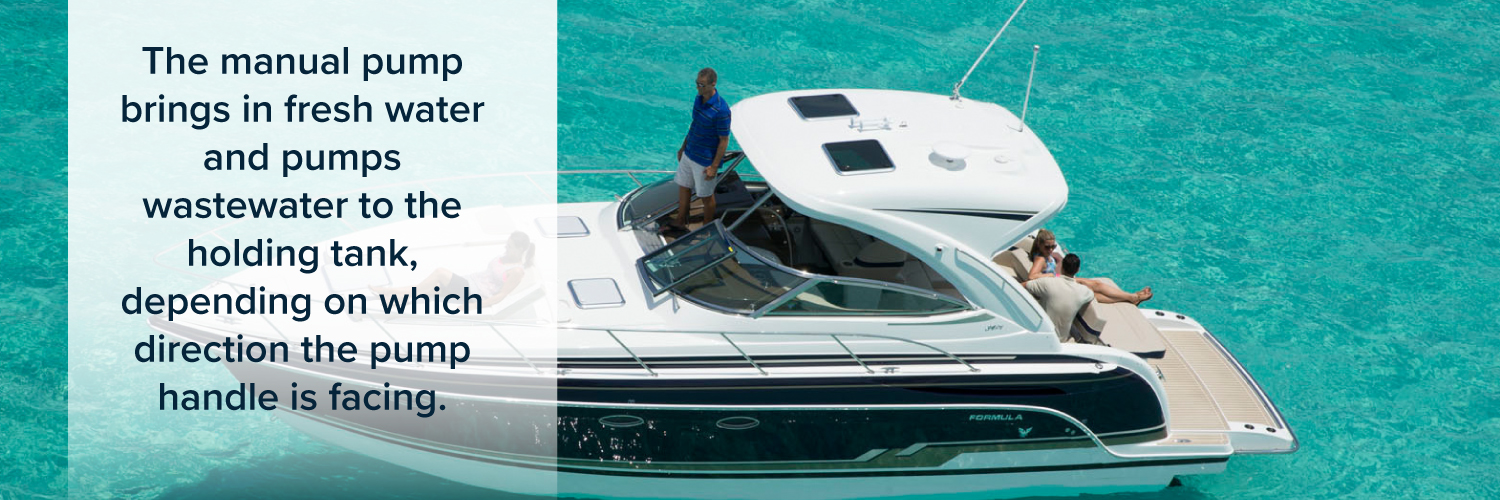
- Electric pump: These pumps, like the Vacuflush units available in the majority of Formula Boats models, use the freshwater system of your boat for their water supply and flush using a vacuum generated by an electric pump and a vacuum holding tank. To use this type, you need to turn on the waste system and/or the head pump breakers at the cabin electrical panel. Lift up on the flush lever to draw some fresh water into the bowl. Then, to flush, push down on the flush lever. The vacuum draws the waste through a constricted opening at the bottom of the head, fragmenting it before it travels to the holding tank.
Once you’ve decided which type of operation you prefer, the next step is to choose a plumbing system configuration — that is, what discharge options you want to have.
- Pump-out holding tanks: Holding tanks may exclusively come with a pump-out option. This type — sometimes referred to as a coastal holding tank — is meant for those who use pump-out facilities 100 percent of the time and do not have a need for a self-discharge option. If you use your boat within three miles of the coast, you can’t legally discharge your waste overboard, so this option may be the perfect match for your use. It’s important to look into pump-out facility locations and to plan accordingly — if the holding tank is full, you can no longer use it.
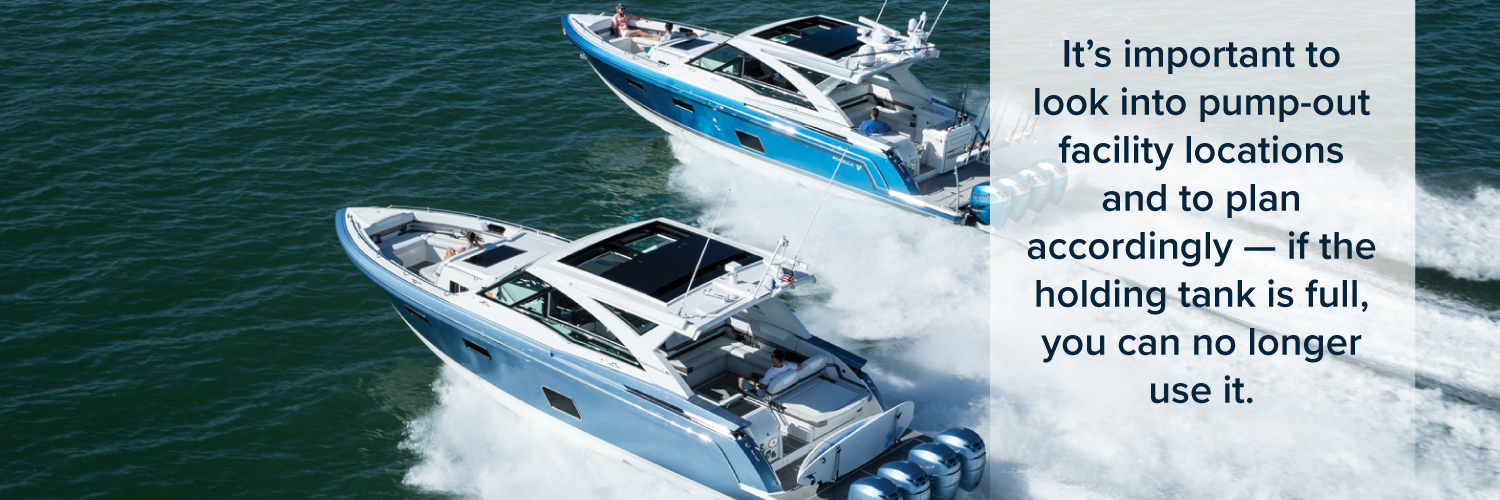
- Pump-out holding tanks with overboard discharge option: If you’re choosing a marine head system for your boat, travel in areas where dumping waste is legal and want to have the option to discharge overboard, this is a great option. Sometimes called an offshore or coastal hybrid tank, this model has a Y-valve located between the toilet and the holding tank, giving you the option to switch it to discharge overboard if and when it’s legal, or keep it switched to the holding tank when you’re in areas where dumping is illegal. The downside to this model is the risk of accidental discharge, which authorities don’t like to see. Plus, if the holding tank is full, your head will be out of order.
- Holding tanks with multiple options: This one is the most versatile holding tank head system and the one we’ve chosen as the standard in all our Formula Boats Cruiser and Super Sport models. In this type, all waste goes from the toilet through a hose and into the holding tank. The Y-valve gets installed after the holding tank, giving you the opportunity to store waste in the holding tank and then either use a pump-out facility or discharge through a macerator pump when you legally can. Many wonder, “How does a macerator pump work on a boat?” The answer is that when you switch the Y-valve to discharge the holding tank, it goes out through a macerator pump, which grinds up all the waste before discharge. This option is available in Formula Boats models through the addition of the optional macerator system.
Marine Sanitation Systems
The third type of head system is marine sanitation systems — these systems do not need a holding tank because they treat the waste to eliminate harmful bacteria and contain a macerating pump, which grinds the waste into sludge and discharges it overboard. Due to the complexity of these marine sanitation systems, and their price tag, they are usually on large, live-aboard boats. Despite the fact that these systems sanitize the waste, and make dumping waste legal in most cases, boaters with these systems are still required to observe the No-Discharge Zones designated by the Environmental Protection Agency.
Tips for Dealing With Holding Tanks
Unless you’re interested in a porta-potty or own a large, live-aboard yacht, choosing a marine toilet often involves learning how to use and maintain a holding tank, also called a waste tank. While these tanks are certainly manageable, they are not something boat owners can afford to neglect. Here are a few key things to keep in mind if you have a head system with a holding tank.
Monitor Your Holding Tank Level
This may seem like a no-brainer, but make sure you are aware of how full your holding tank is and pump it routinely. While tank indicators may differ slightly, all of them clearly show when your tank is full. In Formula Boats models, we’ve equipped them with a safety mechanism that shuts down the head pump, which disables the toilet’s flush when the waste tank is full. While it may seem like a nuisance, the purpose is to protect you from overfilling the tank and creating a mess.
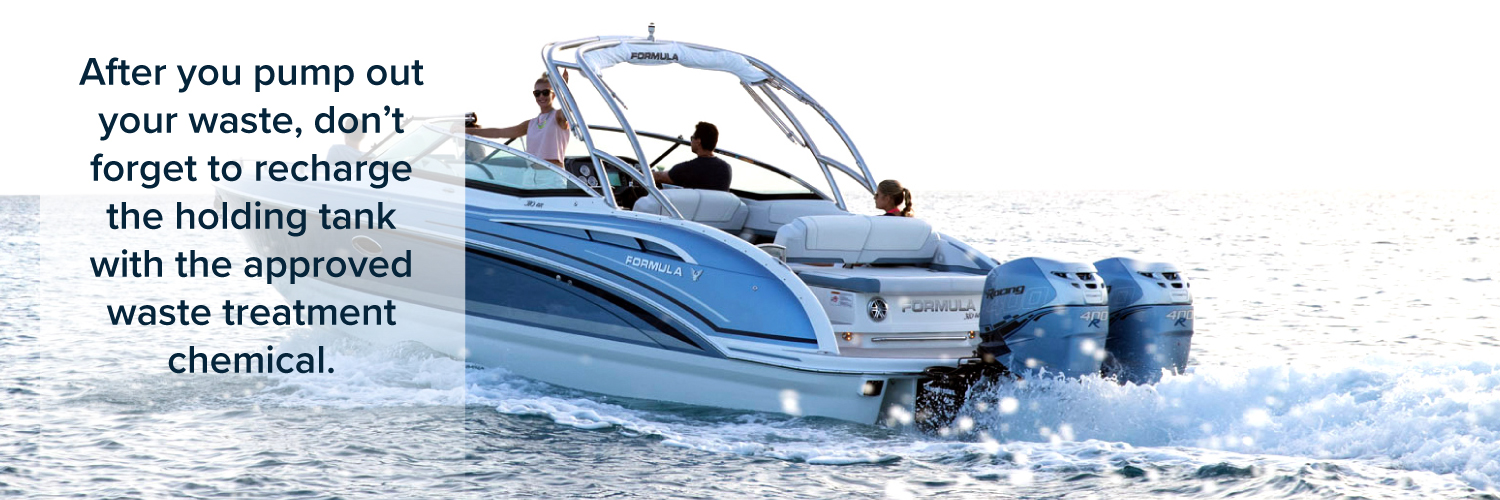
Recharge with Waste Treatment Chemicals
After you pump out your waste, don’t forget to recharge the holding tank with the approved waste treatment chemical. While your holding tank system isn’t a marine sanitation system, there is still some level of sanitation and breakdown involved when you’re dealing with waste. Flushing it through the head system can also help. For specifics, follow the instructions in your marine toilet manufacturer’s operation manual.
Don’t Forget About the Seacock
If you can discharge through a macerator pump legally, don’t forget to open this valve. Otherwise, your macerator will be trying to pump waste with no place to push it. The result could be a burned-out macerator — or, if a fitting gives out, the creation of a brand-new holding tank: your engine compartment.
Use Deodorizers Regularly
It shouldn’t come as a surprise that smells can accumulate in a holding tank over time. Rather than waiting until a smell develops, use deodorizers regularly to help prevent a problem from arising. Again, for specifics on what to use and how often, it’s best to consult your marine toilet manufacturer’s operation manual.
Marine Head Maintenance Tips
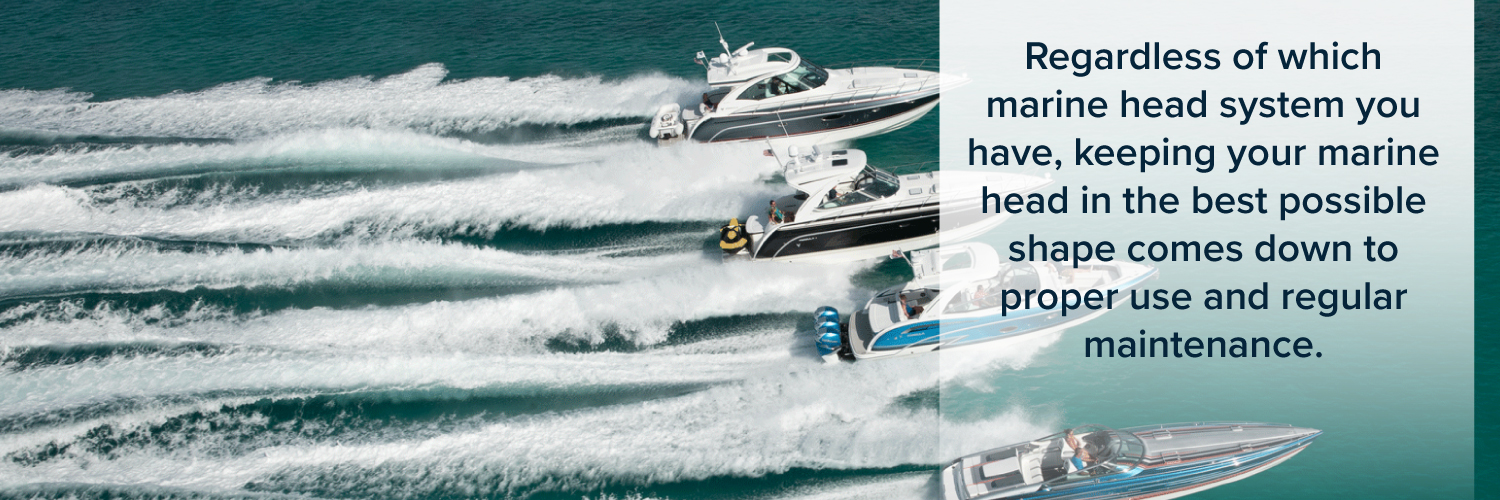
Regardless of which marine head system you have, keeping your marine head in the best possible shape comes down to proper use and regular maintenance — and replacement, as needed. If you are diligent in these areas, you will be able to avoid marine toilet problems and extend the life of your head system. Here are a few specific tips we have for maintaining your marine head.
Educate Guests On Marine Head Etiquette
Yes, toilet talk before you head out on a boating adventure may be awkward, but what’s even worse is having to pick your guests’ unmentionables out of a clogged head in the middle of your fun getaway. If they don’t own a boat with a head, chances are they don’t know — and so it’s your job to educate them. Just like with a toilet on land, you shouldn’t flush anything except toilet paper and human waste. Period.
Flush Waste Using Freshwater
If you have a Vacuflush head, this tip is easy because your unit uses the freshwater system of your boat for its water supply. For all others, it’s tempting to use raw water — it surrounds your boat and doesn’t require any additional effort. Unfortunately, all the microorganisms that live in raw water, combined with waste, creates a stench that will leave your friends running in the opposite direction. Instead, use freshwater. Keep a few jugs of water in the head compartment and set the intake level to “dry” or “dry flush.” Then use about half of a half-gallon jug for liquid waste and one entire half-gallon jug for solid waste.
Keep It Clean
Whenever you dump out the holding tank, fill the toilet bowl with clean water and flush. Next, pump out the holding tank. If you have a macerator pump, use it. Every so often — especially when leaving the boat for a long time — use more water and diluted, biodegradable detergent to clean the system. A gallon or two will suffice for a self-contained portable toilet. For Formula Boats models, five gallons is enough for the manual pump head and Vacuflush heads. Run it through all the parts of your system to remove sludge and debris and to prolong the lifespan of your equipment. In your cleaning efforts, never use harsh chemicals like commercial drain cleaners, which will corrode your seals and hoses.
Get A Repair Kit
Purchase a repair kit with parts specifically for your make and model of marine head — it’ll contain flapper valves, joker valves and seals, plus other parts that could fail. Then, whether you’re in the middle of a day on the water or in between seasons, you have the parts you need to complete a repair and won’t get stuck without a working marine head.
Winterize It Properly
If you’re getting your boat ready for winter, make sure to fully drain all water from all freshwater lines, as well as the head and holding tank. Add non-toxic RV antifreeze to the freshwater tank and flush a sufficient amount of antifreeze through the hoses and into the holding tank. Avoid using alcohol-based antifreeze, as it can create tiny holes in the sanitation hoses and lead to an odor problem. When you’re getting your boat ready for a new season, check the tightness of all hose clamps, install a new holding tank vent filter and scrub holding tank sensor probes with a hard-bristled brush.
Replace Parts Wisely
At some point, you’ll need to replace the parts of your marine head system. When you do, make sure you do your homework. While it may be tempting to choose a cheap option, investing in the high-grade hoses can make a big difference, as they will not absorb the smell as easily.
Discharge Laws
As a boater, it is your responsibility to know the federal regulations, as well as any local regulations regarding marine head systems and discharge in your area. We can’t speak to all the local laws where you live, but we can give you an overview of the federal regulations.
Federal regulations on marine head systems came from concerns regarding the bacteria and pathogens in human feces. Many people swim in and drink the water inland and in coastal waters — so the federal government determined it would not permit the presence of this untreated sewage in these areas.
In 1972, the government banned the discharge of untreated sewage into inland waters — including rivers, lakes, etc. — or coastal waters within three miles of the shore. That means unless you have a marine sanitation system, which translates to treated sewage, you are not allowed to discharge any waste within three miles of the coast and in rivers, lakes and other inland waters.
The EPA has also established No-Discharge Zones , where no discharge of any waste — treated or untreated — is permitted. Make sure you know the No-Discharge Zones in your area and avoid discharging any waste in those areas.
If you have a marine head system with a Y-valve between the toilet and the holding tank, the U.S. Coast Guard and most marine law enforcement agencies require the Y-valve to be padlocked to the holding tank position while in use in coastal waters. This requirement is meant to protect against accidental discharge in an area where the discharge of untreated sewage is illegal.
By familiarizing yourself with the federal and local regulations, you can ensure you’re operating your marine head system safely and legally and doing your part to keep the environment clean.
Choosing a Head System for Your Custom Boat
Selecting a head system for your boat is essential, as you want to make sure you have one that gives you what you need to abide by the regulations, but also to add convenience to your boating adventures with family and friends. As a boat manufacturer for more than 40 years, we have experience with a variety of head systems and have selected those that are the best balance of convenience, affordability and safety for our customers.
Formula Boats gives you the ability to customize boat models, empowering you to choose everything from the head system to the paint. Get started with our online boat builder . When you’re ready to take the next step, find the dealer closest to you to begin bringing your custom boat to life. Have questions in the process? Our team is here to help. All you have to do is contact us .
Contact Dealer
This site is protected by reCAPTCHA and the Google Privacy Policy and Terms of Service apply
- --> Login or Sign Up

- Things You Should Know!
What’s the Best Toilet Paper for Your Marine Toilet?
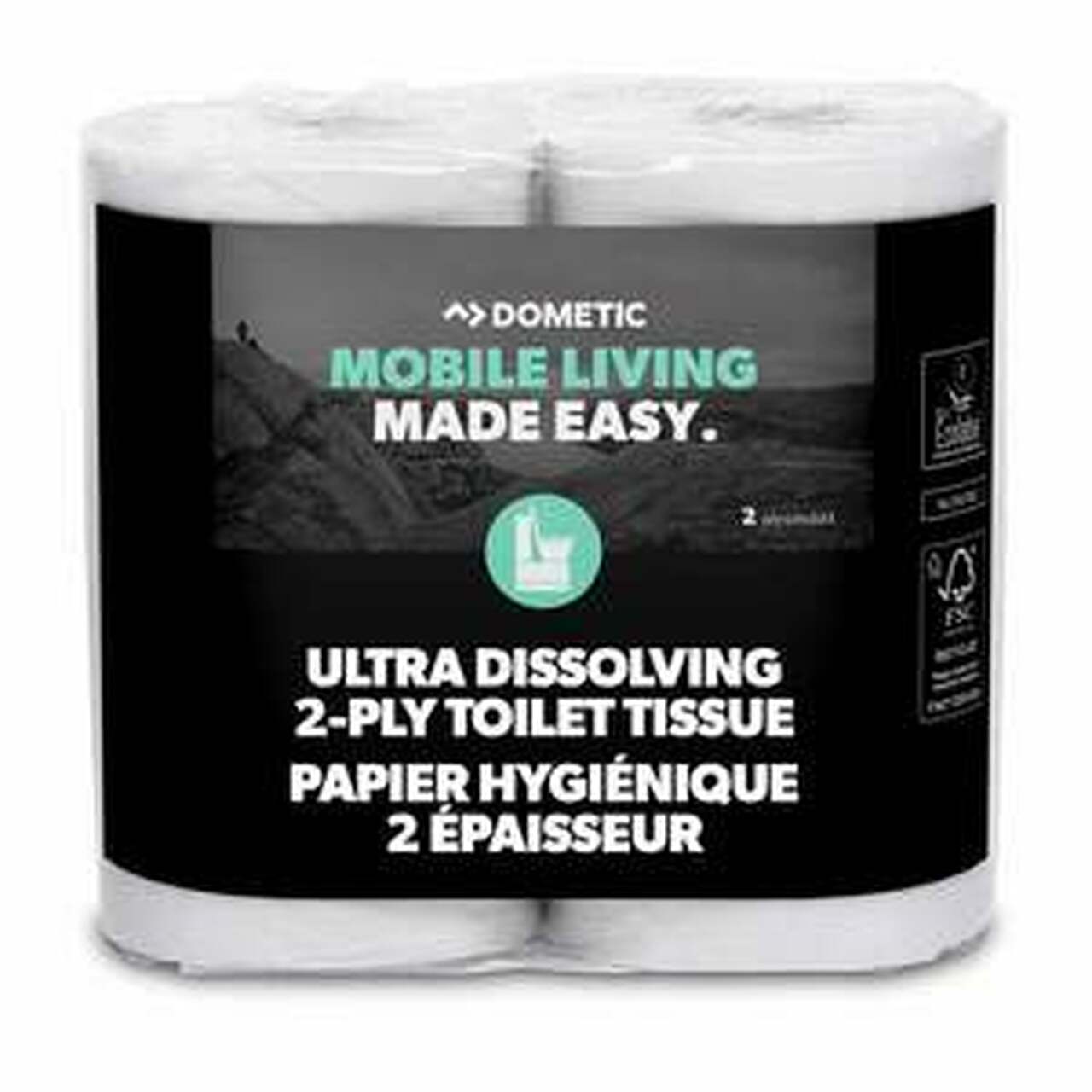
25th Jan 2022
You’ve just installed your new marine toilet and you’re ready to set out for an extended voyage. Everything is ready to go except for one little problem…
You forgot to buy toilet paper.
No problem, you think. Just swing by the grocery store and grab a package on your way to the docks. Toilet paper is toilet paper, right?
Unfortunately, no. Using the wrong paper could leave you with a clogged marine toilet at the worst possible time. Make sure your voyage remains a safe and sanitary one by choosing the right marine toilet paper for the job.
Not Just Another Toilet
Marine toilets are extremely reliable and can manage waste effectively, but your on-board septic system isn’t quite as hardy as your home plumbing. That’s because while your home toilet empties into a 4” wide drain, marine toilets plumbing is only 1½” wide. Given those dimensions, any inorganic material flushed down the drain will quickly create blockages that can seriously damage the pump or even crack the porcelain throne.
A good rule of thumb , of course, is to simply avoid using the marine toilet as a trash can. Things like paper towels, feminine hygiene products, and antibacterial wipes, for instance, should never be flushed down your marine sanitary system under any circumstances. These heavy, nonbiodegradable items are certain to cause blockages.
Toilet paper is the one exception to this rule of thumb, but don’t go thinking that you can simply grab a few rolls from your bathroom closet before heading out on the boat for the weekend. Although household toilet paper sheets are technically biodegradable, they’re designed to break down over time within a septic tank or sewage system, not a marine holding tank. When toilet paper doesn’t dissolve quickly enough, it accumulates in clumps that can easily clog up your marine sanitation system.
Marine Toilet Paper vs Regular Toilet Paper
The safest bet is to ensure your toilet remains in good working order is to only use one of the many marine toilet paper brands available. You can usually find a package wherever boating supplies are sold or from most online retailers.
Although it may look (and feel) identical to household toilet paper, marine toilet paper is specially designed to dissolve more rapidly and is 100% biodegradable. You can find it in both 1-ply and a more comfortable 2-ply thickness. Since RV septic systems face many of the same challenges as marine systems, most brands can be safely used in both.
Dometic Ultra 2-ply marine toilet paper is a good example of a specialized tissue product that’s designed to break apart quickly to maintain optimal toilet system flow. Made with 100% recycled fibers, it provides the comfort of household toilet paper without the same risk of creating clogs.
Can You Use Household Toilet Paper in a Pinch?
While marine toilet manufacturers recommended using only marine/RV toilet paper, there are plenty of times when you may be setting sail on short notice and aren’t able to find the right toilet tissue. Luckily, there is a simple test that can give you an idea of whether or not that roll of “off the shelf” toilet paper is likely to create clogs.
For starters, don’t bother with 2-ply or quilted household toilet paper. It’s simply too heavy-duty for your marine toilet system to handle and is sure to cause a blockage of some kind. However, inexpensive 1-ply tissue is often lightweight enough to break down quickly, provided it’s 100% biodegradable.
Here’s a quick and easy way to test your toilet paper:
- Get an empty glass jar
- Fill the jar at least three quarters of the way full with water
- Insert two sheets of toilet paper
- Shake forcefully for 30 seconds
If the toilet paper is shredded and dissolving into the water, it should be safe for your marine toilet. For a more thorough test, you can place a wad of toilet paper (about as much as someone might actually use) into a jar of lukewarm water, stir for five seconds, let it soak for five minutes, and then stir it again for five seconds. If the paper hasn’t turned to pulp before the five-minute soaking period ends, you probably shouldn’t risk flushing it down your marine toilet.
Following these basic guidelines will help you keep your marine sanitation system running smoothly whether you’re using a manual or electric flush system. Keeping your plumbing free of clogs ensures that you’ll enjoy many years of worry-free voyages.
For more information about how to best care for your Dometic/Sealand toilet or other components of your marine sanitation system, talk to the team at Environmental Marine today.
- #Boat Toilet Paper
- #Dometic Toilet Paper
- #Marine Toilet Paper
Share This Article
- BOAT OF THE YEAR
- Newsletters
- Sailboat Reviews
- Boating Safety
- Sails and Rigging
- Maintenance
- Sailing Totem
- Sailor & Galley
- Living Aboard
- Destinations
- Gear & Electronics
- Charter Resources
- Ultimate Boating Giveaway

Upgrading Your Marine Toilet
- By Jen Brett
- Updated: July 7, 2020
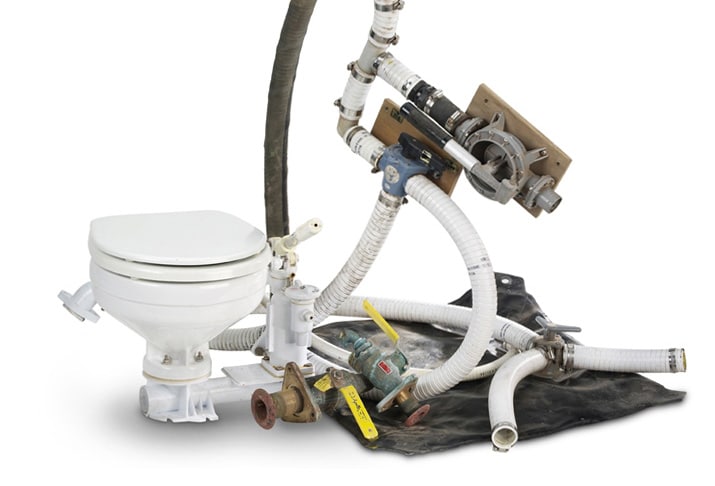
Just about every sailor has a head story, which is usually humorous and quite likely fairly gross. These stories typically include massive clogs, holding-tank issues, or pump malfunctions that occur at just the wrong time (really, is there a right time?), followed by a debate over marine and environmental issues and the merits of replacing the whole marine toilet system with just a bucket. And while a bucket may eliminate plumbing and holding tanks, the experience of using and dumping said tub leaves something to be desired. Fortunately, sailors today have more boat toilet choices than in the past, and those choices are more reliable and cost efficient than ever.
Unlike household toilets, which are all pretty much the same, marine toilets come in different shapes and sizes and have different flush mechanisms and tank options, so you can design a system that works for your boat, budget, and cruising plans. While the emphasis here will be on what’s available in marine heads, this is also the time to take a look at what the experts refer to as the marine-sanitation-device system. New, high-quality, sanitation-grade hoses, a clear vent hose, and a new or scrubbed-out holding tank will go a long way to ensuring that the system operates as efficiently and as free of odor as possible. If replacing your head and related sanitation gear is in your future, you may want to consider an upgrade to an electric head, a vacuum head, or even a composting head. Or if you’re on a tight budget, you can always go back to basics, so to speak.
Manual Boat Toilets ($200 to $1,750)
Keeping it simple certainly has its merits, and manual boat toilets have done the job for years. From the venerable (but now hard to find) Wilcox-Crittenden Skipper head to the widely available Jabsco manual head ($200), cruising sailors have relied on these due to ease of use, simple system designs, readily available rebuild kits, and, in the case of the Jabsco, low replacement cost. If you’re going to replace your head with another manual boat toilet, consider looking for one that’s pumped with a back-and-forth motion, such as the Groco K-H manual head ($1,750), because many people find this easier than an up-and-down motion. A bronze base is more robust than a plastic one and may hold up longer, too, and a large joker valve clogs less frequently.
Electric Marine Toilets ($550 to more than $1,600)
A common marine toilet upgrade is to go electric, which can sometimes be as simple as installing an electric pump in an already compatible system. An electric marine toilet eliminates the need to manually pump, pump, pump to clear the bowl. Electric heads also typically include a macerator as well, which is similar to a garbage disposal and grinds up waste and paper before discharge into the holding tank (or overboard, if you’re offshore). All you do is push a button. This simplicity is nice if you frequently have landlubbers aboard. “They’re easy to use for those who come on board and aren’t familiar with a marine system, and they do a good job of chopping up any solids before it enters the sanitation hose, reducing the possibility of a clog,” says John Corbishley of Ocean Link ( oceanlinkinc.com ), a marine-systems specialist with an office in Portsmouth, Rhode Island.
Some electric marine toilets, such as the Jabsco Lite-Flush ($659), are designed as a direct replacement for a specific manual head, which typically makes for easier installation. “When choosing a macerating electric head, another element that we consider is access to the moving parts,” Corbishley continues. “If they’re located in more than one area, like a locker or under a platform, they’re much harder to service. The macerator blades are one of the major components to fail when the wrong thing is introduced to the toilet, so they need to stand up to the job.”
Electricity consumption, which is almost always a concern on cruising boats, is something to think about when switching to an electric marine toilet. Corbishley says that the draw on the electrical system is minimal on a typical modern cruising boat. However, he notes that when the head is used, there is a brief load burst of between 20 and 30 amps, so each head should have its own breaker, either at the boat’s panel or a separate breaker somewhere else.
An electric macerating toilet that Corbishley recommends to his customers who are looking to upgrade the head on their sailboats is Saniflo’s SaniMarin (from $670). He notes that the parts are all located under the china bowl and that by undoing three screws, you can pivot the unit and gain access to those inner workings. The macerator blade is stainless steel, and the pump is quite powerful, which reduces clogs.
If nothing’s too good for your boat and you’re truly looking for a throne, Tecma’s X-Light carbon-fiber head may suit your fancy. It’s the most expensive head that we could find (not to mention the coolest-looking one!), at prices that start at just over $10,000.
Vacuum Marine Toilets ($400 to $2,000)
Vacuum systems have been used on larger poweryachts for many years. They work well; however, since the systems are usually large and use fresh water to flush, many sailors have stayed away from them. A new product from Dometic may change that.
The SailVac holding-tank system, when paired with one of its VacuFlush marine toilets ($1,670 for both), is specifically designed for the small spaces typically found on most sailboats ( editor’s note July 2020: Dometic does not seem to be producing the SailVac any longer ). The SailVac combines a vacuum pump, vacuum reservoir, and holding tank into one unit. A real benefit of vacuum systems is that although they use fresh water to flush, they use only a very modest amount, usually around a pint or so. They also typically use much less power (three amps at 12 volts DC for the SailVac) than a standard macerating electric head.
Popular among sailors for its reliability, the Lavac head (from $440) also uses vacuum pressure to clear the bowl, but it works differently than the SailVac system. When you close the lid on the Lavac, a seal forms. A diaphragm pump, the only moving part, then creates a vacuum, which pulls out the waste and draws in the flush water. After a few seconds, the vacuum breaks, and the toilet is ready to be used again.
After using a Lavac head on some other boats, cruising sailor Brian Cole decided to install one on his own vessel. After using it for a couple of years, he offers a few thoughts. On the plus side, since the pump is external and has simple gaskets, the Lavac is easy to fix and rarely clogs.
However, Cole finds that the Lavac uses more water for a full flush than does a manual head, and the normal installation requires a user to wait about 30 seconds before being able to open the lid, which can be a problem if there’s an ill person on board. “Other than that,” Cole says, “I’d recommend the Lavac over any head that we’ve ever had or used on board. The simplicity is wonderful. The installation does require a little more thought, but the long-term repair benefits are worth it.”
Composting Toilets ($800 to $1,000)
A relative newcomer to the marine-toilet marketplace, composting heads are starting to make their way onto more boats. Such composting heads as the Air Head ($1,030) or Nature’s Head ($925) offer a major benefit over other systems in that they require no through-hulls. Both toilets work in the same way: Moist, crumbled peat moss is put in the composting chamber at the bottom portion of the toilet. When the toilet is used, liquid waste is channeled into a separate tank, while solid waste goes into the composting chamber. You turn a crank handle, which agitates the contents; the process to transform it all into compost begins immediately. An integral 12-volt vent fan keeps the compost dry and hastens the process. According to Air Head, the solid tank has enough capacity for a couple to use it during a month of living aboard before needing to empty it; however, the liquid tank needs to be emptied every two or three days.
Although sailors switching over to a composting head will definitely have to deal with a learning curve—not to mention the job of removing all parts of the previous system—the composting head, when set up and maintained properly, should be free of odor, and you’ll never have to worry about clogged hoses or finding pumpout stations again.The marine head has certainly come a long way from its beginnings as a hole in the bow of a ship, and while you’ll still probably need to give thorough instructions on head procedures to all your onboard guests, with the many advances in toilets and M.S.D. systems, those gross, though amusing, head stories may become a thing of the past.Installing a new marine toilet is within the skill set of most do-it-yourselfers, but if you’re completely redesigning your system or, say, upgrading from a manual head to a vacuum system, you may want to consult with someone who has experience with marine plumbing.
Jen Brett, CW senior editor, is a liveaboard sailor who’s somehow managed to convince her husband to do all of the head rebuilds—so far.
- More: How To , plumbing , ship's systems , systems
- More How To

Surviving the Storm: A Sailor’s Tale of Hurricane Lee

Best Practices for Boat-Show Shopping

Grease the Wheels of Your Boat: A Guide to Proper Lubrication

A Bowsprit Reborn: A DIY Renovation Story

Savoring Superior: A Great Lakes Cruise To Remember
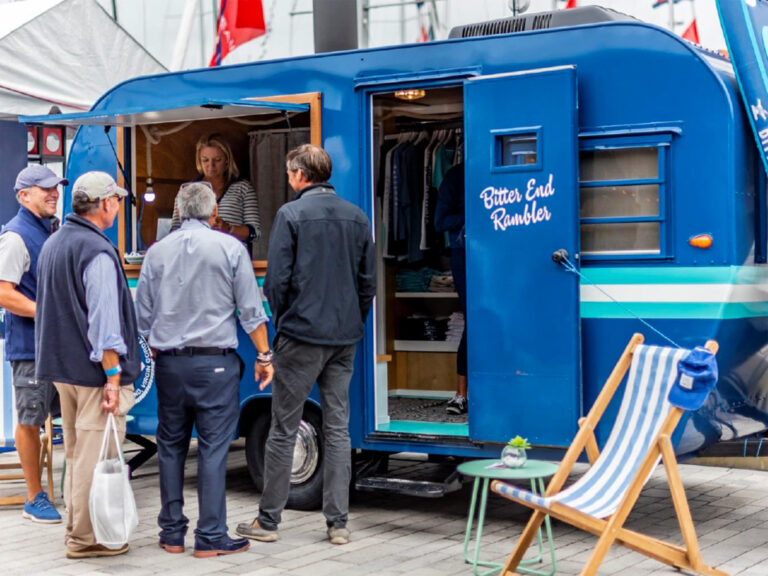
Point Your Compass Due South, Bitter End Yacht Club Reopens October 23rd.
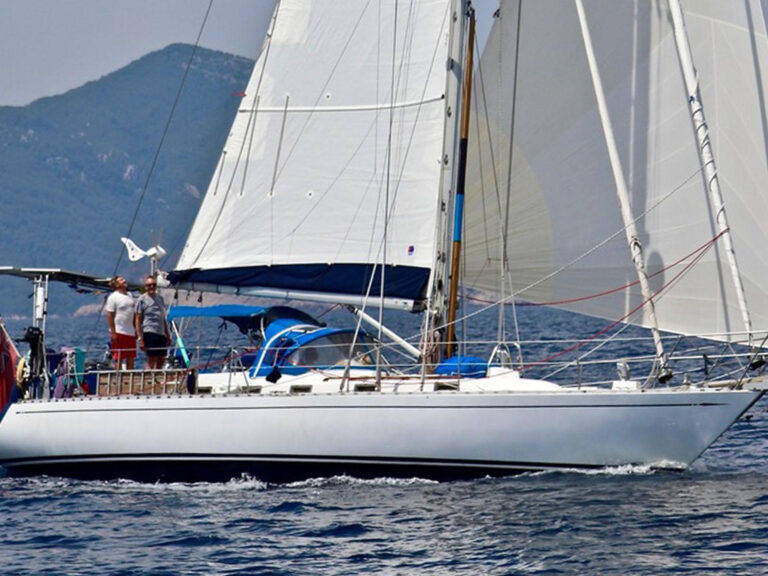
Pre-Owned: 1988 Hylas 47
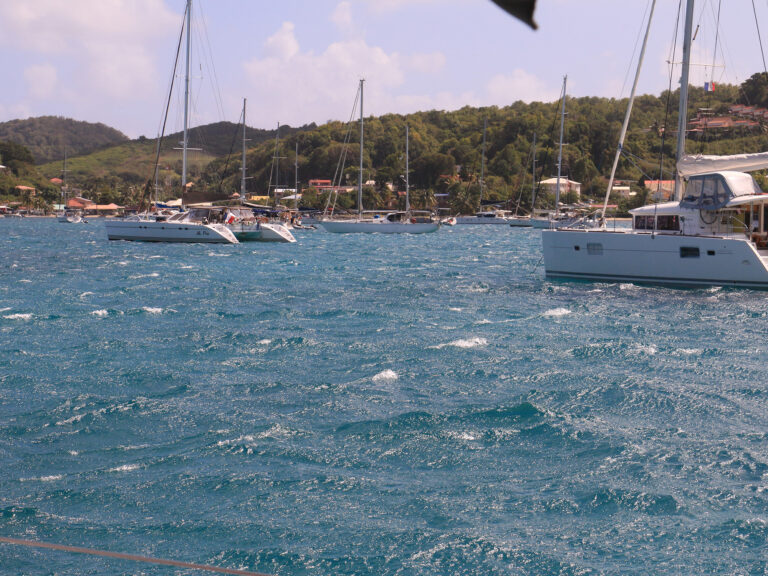
Understanding Wind in the West Indies
- Digital Edition
- Customer Service
- Privacy Policy
- Terms of Use
- Email Newsletters
- Cruising World
- Sailing World
- Salt Water Sportsman
- Sport Fishing
- Wakeboarding

Please verify you are a human
Access to this page has been denied because we believe you are using automation tools to browse the website.
This may happen as a result of the following:
- Javascript is disabled or blocked by an extension (ad blockers for example)
- Your browser does not support cookies
Please make sure that Javascript and cookies are enabled on your browser and that you are not blocking them from loading.
Reference ID: 04002c98-76fc-11ef-a384-1dc0e7821167
Powered by PerimeterX , Inc.
Visit our Popular Forums
- Monohull Sailboats
- Multihull Sailboats
- Powered Boats
- General Sailing
- Antares Yachts
- Fountaine Pajot
- Lagoon Catamarans
Cruising Business
- Boat Classifieds
- General Classifieds
- Crew Positions
- Commercial Posts
- Vendor Spotlight
Life Aboard a Boat
- Provisioning: Food & Drink
- Families, Kids, & Pets Afloat
- Recreation, Entertainment, & Fun
- Boat Ownership & Making a Living
- Liveaboard's Forum
Seamanship, Navigation & Boat Handling
- Seamanship & Boat Handling
- Training, Licensing, & Certification
- Health, Safety, & Related Gear
- Rules of the Road, Regulations, & Red Tape
Engineering & Systems
- Const. / Maint. / Refit
- Product / Service Reviews
- Electronics: Comms / AV
- Electrical: Batts / Gen / Solar
- Lithium Power Systems
- Engines & Propulsion
- Propellers & Drive Systems
- Plumbing / Fixtures
- Deck Hdw: Rigging / Sails
- Aux. Equipment & Dinghy
- Anchoring & Mooring

Photo Categories
- Member Galleries
- Life Onboard
- Sailing in the Wind
- Power Boats
- Cruising Destinations
- Maint. & Boat Building
- Marine Life
- Scuba Diving & Divers
- General Photos
Recent Photos

Listing Categories
- African Cats
- view more »
- Crew Wanted
- Crew Available
- Enhance Your Account
- Meet the Mods
- Meet the Advisors
- Signup for The Daily Cruiser Email

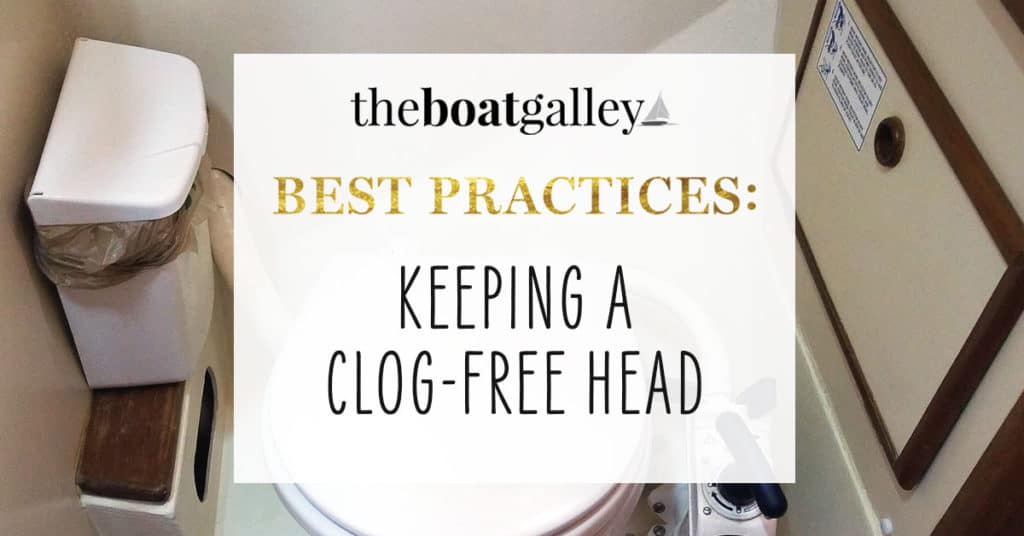
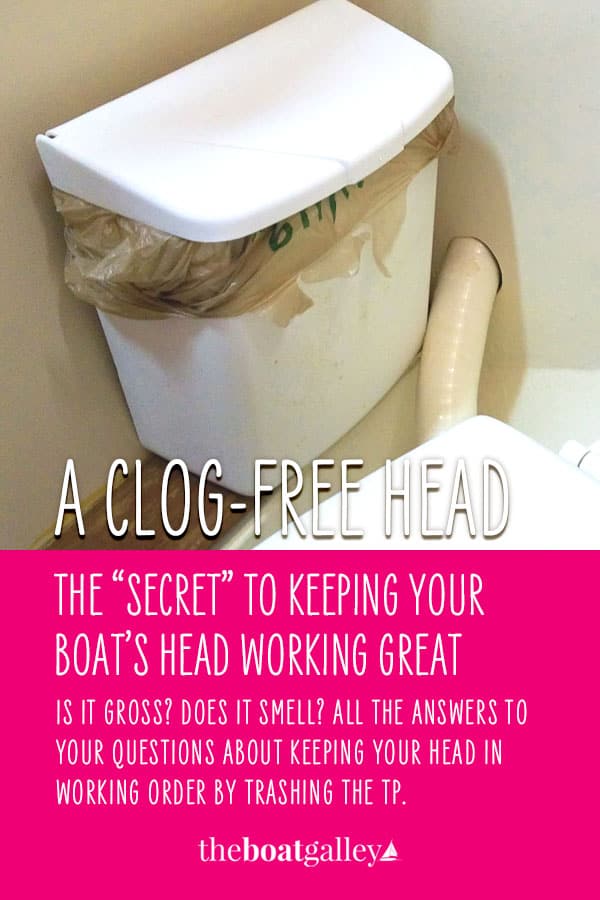
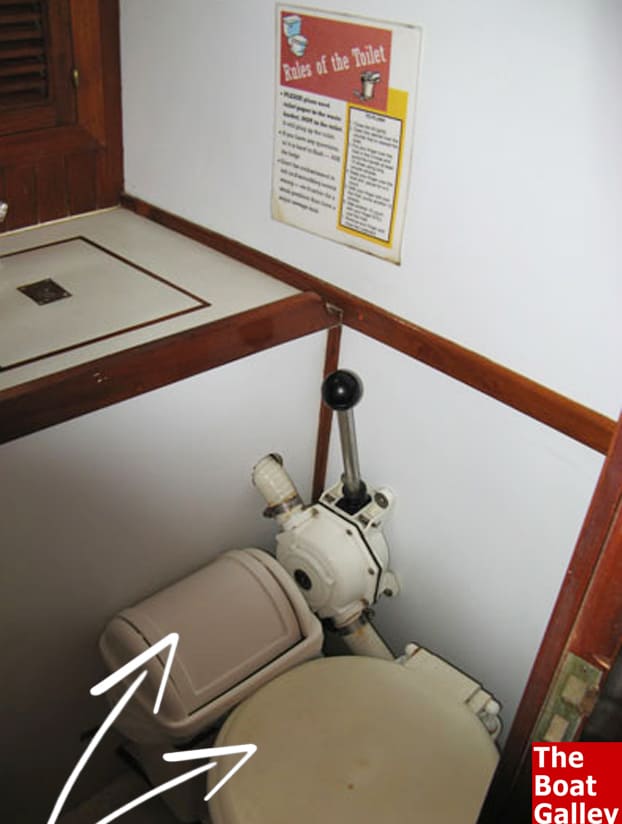
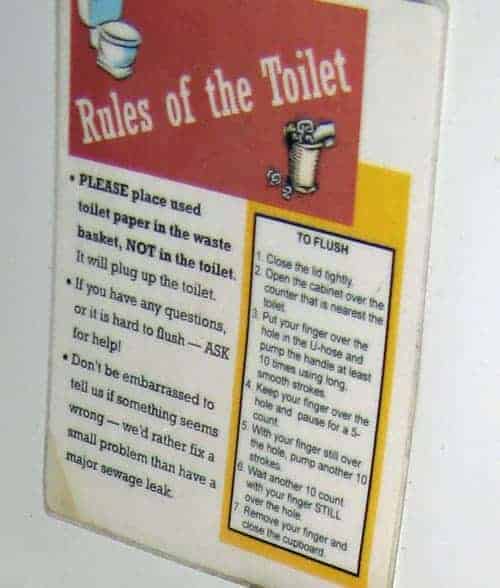
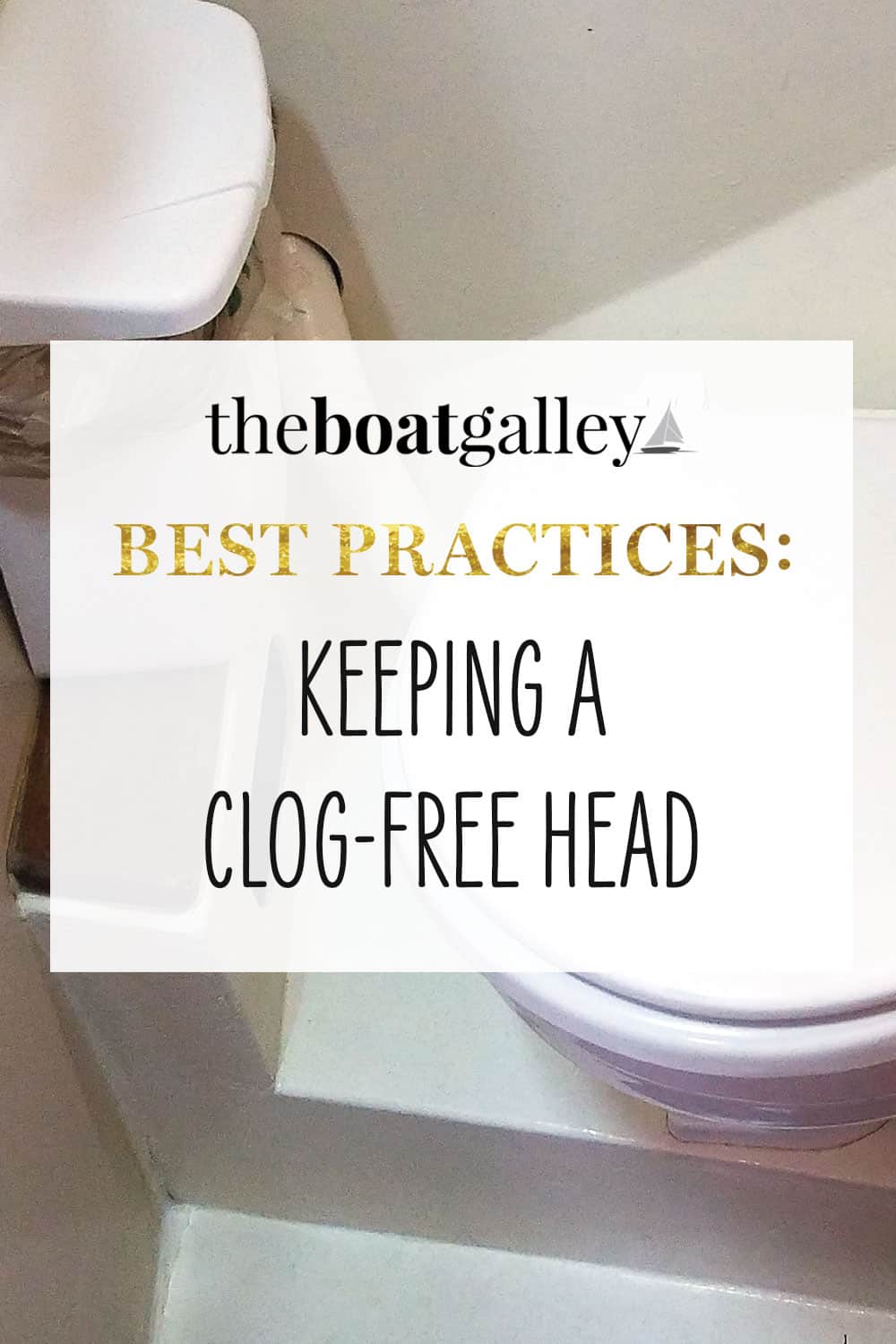


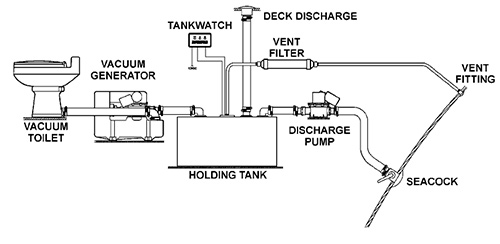




















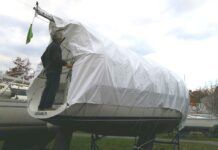


























IMAGES
VIDEO
COMMENTS
We tested single-ply toilet paper, double-ply toilet paper, and facial tissues. We dropped paper towels from the report because of their poor performance. Tested brands included Dometic, Coleman, Scott (Kimberly-Clark), Thetford, Giant, Camco, Charmin, Marcal, Seventh Generation, West Marine, and Proctor & Gamble (Puffs and Charmin).
Toilet Tissue vs Marine Heads. Some sturdy sailors have no issues with putting used toilet tissue in a plastic bag for later disposal so as to put off the clogged head Day of Ugliness. But others are more bonded to shoreside habits or have spouses or crew who'd jump ship at the thought of not being able to flush the paper.
Best Marine Toilet Paper For Boats - The Top Rated! If you're a boat owner, you know how important it is to have the right toilet paper on board. Regular household toilet paper isn't recommended, as it can clog your boat's sanitation system and lead to costly repairs. So it's crucial to make the right choice.
Marine toilet paper used on a sailboat? Or household toilet paper used on a sailboat? Your thoughts please. With a marine holding tank and macerator.
Head cleaning and maintenance. Cleaning your boat's head system is a project you don't want to put off. 1) Cleaning the bowl and seat are the same as any household toilet so be sure to do this after every outing. 2) Discard any toilet paper bags or empty the bins. 3) Pump out the holding tank after every trip.
Guide To Head Systems and Maintenance July 16, 2018 Boat Care Choosing a marine toilet, also known as a head system, is not an easy feat. There are a variety of marine sanitation systems that all work a little differently and come at a range of price points. Once you've chosen the head system for your boat, you need to keep up with maintenance — while the overall upkeep is similar, the ...
Composting Heads for Cruising Sailboats After a decade of trouble-free use, the conventional marine toilet on their 41-footer developed issues. Was a composting head the answer? By Heather Francis Updated: August 2, 2021
Understand what it is important to use marine specific toiler paper for your marine toilet. Offering useful tips related to marine toilets and toilet paper.
If you're looking for a new marine toilet for your sailboat, choices include manual, electric, vacuum and composting heads.
Composting Toilets ($800 to $1,000) A relative newcomer to the marine-toilet marketplace, composting heads are starting to make their way onto more boats. Such composting heads as the Air Head ($1,030) or Nature's Head ($925) offer a major benefit over other systems in that they require no through-hulls.
Alex Smith explains the basics of marine toilets, also known as 'heads', including top tips and some key marine toilet models. If you've ever enjoyed fishing, cruising or family boating, you will know that a boat with a toilet (also known in 'marine speak' as 'heads') is infinitely better than one without. However, given that water, energy ...
West Marine 2-Ply Ultra Soft Toilet Tissue: The Best Thing to Happen to Your Boat or RV Since the Invention of the Toilet! Say goodbye to clogs and plumbing nightmares with West Marine's 2-Ply Ultra Soft Toilet Tissue.
An alternative is to stop using toilet paper and use a spray system (like a bidet), but there are problems there as well - again, it depends in part on your families' intestinal conditions. To prevent clogging, be sure to use enough water and chemicals. More TP = more water.
A clogged head usually means a nasty job where you have to take the toilet halfway apart. Many cruisers follow this rule and go years without a clog.
Bottom line: Initially developed for the houseboat rental market-renowned for marine toilet neophytes-this is an industrial-strength head. Although it will be a tough squeeze in an average cruising boat, it fits the bill for the boat owner with a steady supply of careless visitors or charter guests.
Browse our huge selection of boat bathroom hardware, toilet paper and paper towel holders and more at closeout prices. Shop Today.
Marine toilets are designed to allow for sanitary conditions while out at sea. It should be evident that a traditional toilet would not work well on a boat. Consider a rough sea and the boat rocking heavily. A traditional toilet would have water spilling from the toilet bowl as the boat rocks. Conversely, marine toilet bowls a kept dry until ...
THE ADVANTAGES Little or no toilet paper use means less clogging of the head plumbing, less build up in the tank, and less to store. After months of use (both male and female), we found that drying with TP is not required, and the bidet definitely does a better job cleaning.
Boat Toilet Systems, Soap Dishes and Parts Keep life aboard clean, comfortable, and convenient with boat head and toilet systems and fittings from Great Lakes Skipper's inventory of new and replacement discount boat parts.
Just recently purchased a used 35 foot sailboat. When sailing her home, I noticed that I could not get water to pump out of the head. I have no problem pumping water in. And yes, I switched the lever to dry when I tryed pumping it out. I believe that it is clogged as tiny bits of toilet paper have starting floating back into the bowl.
RV Toilet Paper Quick Dissolve 2 Ply Septic Safe, Biodegradable, 500-Sheet 12 Rolls Camping Toilet Paper For RVs, Boats, Marine And Campers Rapid Dissolving Toilet Tissue Soft Yet Strong (black) 12 Count (Pack of 1) 300+ bought in past month. $2899 ($5.80/100 Sheets) $27.54 with Subscribe & Save discount. Save 10% with coupon.
In the February and March 2011 issues, Practical Sailor reviewed 14 popular electric-flush marine toilets. All had various types of 12-volt or 24-volt water pumps or macerator pumps to move waste out of the toilet bowl. In our ongoing effort to evaluate on-board sanitation equipment, we had an opportunity to test some toilets that rely on a vacuum (negative air pressure) in the lines for flushing.
Hi Peggy What's the deal with toilet paper? We have an electric macerating Jabsco toilet and using fresh water to flush. Everytime we've chartered a boat the charter people have threatened us within an inch of our life not to flush paper. Now that we live aboard it would sure be nice to be able...